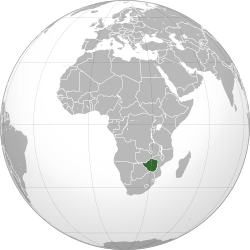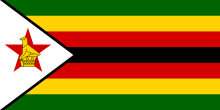زمبابوي
Republic of Zimbabwe | |||||
|---|---|---|---|---|---|
| |||||
شُعار: '"Unity, Freedom, Work"[1] | |||||
 مڪانيت زمبابوي (dark green) | |||||
| گادي جو هنڌ | Harare 17°49′45″S 31°03′08″E / 17.82917°S 31.05222°E | ||||
| سڀ کان وڏو شهر | Harare | ||||
| دفتري ٻوليون | 16 languages:[3] | ||||
| نسلي گروھ (2017[4]) | |||||
| مذهب (2017) |
| ||||
| مقامي آبادي | Zimbabwean Zimbo[5] (colloquial) | ||||
| حڪومت | Unitary presidential republic | ||||
| Emmerson Mnangagwa | |||||
| Constantino Chiwenga | |||||
| Kembo Mohadi | |||||
| مقننه | Parliament | ||||
| Senate | |||||
| National Assembly | |||||
| Independence from the United Kingdom | |||||
• Declared |
11 November 1965 | ||||
• Republic |
2 March 1970 | ||||
| 1 June 1979 | |||||
| 18 April 1980 | |||||
| 15 May 2013 | |||||
| پکيڙ | |||||
• جملي |
390٬757 km2 (150٬872 sq mi) (60th) | ||||
• پاڻي (%) |
1 | ||||
| آبادي | |||||
• 2024 January اندازو |
16,868,409[6] (73rd) | ||||
• 2022 مردم شماري |
15,178,957[7] | ||||
• گھاٽائي |
39 /km2 (101.0 /sq mi) | ||||
| جِي ڊي پي (مساوي قوت خريد ) | 2023 لڳ ڀڳ | ||||
• ڪل |
|||||
• في سيڪڙو |
|||||
| جِي. ڊي. پي (رڳو نالي ۾ ) | 2023 لڳ ڀڳ | ||||
• ڪل |
|||||

زمبابوي ڏکڻ آفريڪا ۾ واقع هڪ زمين بند ملڪ آهي. جنهن جي اتر ۾ زيمبيا، اوڀر ۾ موزمبيق، اولهه ۾ بوٽسوانا ۽ ڏکڻ ۾ ڏکڻ آفريڪا واقع آهي. هتان جي سرڪاری ٻولي انگريزي آهي.
Zimbabwe (/zɪmˈbɑːbweɪ[unsupported input]-wi/), officially the Republic of Zimbabwe, is a landlocked country in Southern Africa, between the Zambezi and Limpopo Rivers, bordered by South Africa to the south, Botswana to the southwest, Zambia to the north, and Mozambique to the east. The capital and largest city is Harare, and the second largest is Bulawayo.
A country of roughly 15 million people as per 2022 census,[15] Zimbabwe's largest ethnic group are the Shona, who make up 80% of the population, followed by the Northern Ndebele and other smaller minorities. Zimbabwe has 16 official languages,[3] with English, Shona, and Ndebele the most common. Zimbabwe is a member of the United Nations, the Southern African Development Community, the African Union, and the Common Market for Eastern and Southern Africa.
Beginning in the 9th century, during its late Iron Age, the Bantu people (who would become the ethnic Shona) built the city-state of Great Zimbabwe; the city-state became one of the major African trade centres by the 11th century but was abandoned by the mid 15th century.[16] From there, the Kingdom of Zimbabwe was established, followed by the Rozvi and Mutapa empires. The British South Africa Company of Cecil Rhodes demarcated the Rhodesia region in 1890 when they conquered Mashonaland and later in 1893 Matabeleland after the First Matabele War. Company rule ended in 1923 with the establishment of Southern Rhodesia as a self-governing British colony. In 1965, the white minority government unilaterally declared independence as Rhodesia. The state endured international isolation and a 15-year guerrilla war with black nationalist forces; this culminated in a peace agreement that established de jure sovereignty as Zimbabwe in April 1980.
Robert Mugabe became Prime Minister of Zimbabwe in 1980, when his ZANU–PF party won the general election following the end of white minority rule and has remained the country's dominant party since. He was the President of Zimbabwe from 1987, after converting the country's initial parliamentary system into a presidential one, until his resignation in 2017. Under Mugabe's authoritarian regime, the state security apparatus dominated the country and was responsible for widespread human rights violations.[17] From 1997 to 2008 the economy experienced consistent decline (and in the latter years, hyperinflation), though it has since seen rapid growth after the use of currencies other than the Zimbabwean dollar was permitted. In 2017, in the wake of over a year of protests against his government as well as Zimbabwe's rapidly declining economy, a coup d'état resulted in Mugabe's resignation. Emmerson Mnangagwa has since served as Zimbabwe's president.

حوالا[سنواريو]
- ↑ "Zimbabwe". The Beaver County Times. 13 September 1981. https://news.google.com/newspapers?id=AFwtAAAAIBAJ&pg=3340,2548451&dq=zimbabwe+unity-freedom-work&hl=en. Retrieved 2 November 2011.
- ↑ "The World Factbook – Zimbabwe". Central Intelligence Agency.
- ↑ 3.0 3.1 "Constitution of Zimbabwe (final draft)" (PDF). Government of Zimbabwe. وقت 2 October 2013 تي اصل (PDF) کان آرڪائيو ٿيل. Unknown parameter
|url-status=ignored (مدد) - ↑ حوالي جي چڪ: Invalid
<ref>tag; no text was provided for refs namedzimstat.co.zw - ↑ "Developments in English". International Association of University Professors of English Conference. Cambridge University Press. 31 October 2014. ISBN 9781107038509. https://books.google.com/books?id=VzXJBAAAQBAJ&pg=PA201.
- ↑ "Zimbabwe Population Live". حاصل ڪيل 23 October 2023.
- ↑ "2022 Population and Housing Census - Preliminary Report - Zimbabwe Data Portal". zimbabwe.opendataforafrica.org. حاصل ڪيل 2023-08-09.
- ↑ 8.0 8.1 8.2 8.3 "World Economic Outlook Database, October 2023 Edition. (Zimbabwe)". IMF.org. International Monetary Fund. حاصل ڪيل 15 October 2023.
- ↑ "Inter Censal Demography Survey 2017 Report" (PDF). Zimbabwe National Statistics Agency.
- ↑ "GINI Index". World Bank. حاصل ڪيل 16 June 2021.
- ↑ "Human Development Report 2023/24". United Nations Development Programme. وقت 19 March 2024 تي اصل کان آرڪائيو ٿيل. حاصل ڪيل 22 March 2023. Unknown parameter
|url-status=ignored (مدد) - ↑ "Zimbabwe introduces new currency as depreciation and rising inflation stoke economic turmoil". Associated Press News.
- ↑ 13.0 13.1 "Zimbabwe adopts new inflation rate based on U.S. dollar, local currency". Reuters. Harare. حاصل ڪيل 25 March 2023.
- ↑ "Zimbabwe Time". Greenwich Mean Time. Greenwich 2000. وقت 19 July 2011 تي اصل کان آرڪائيو ٿيل. حاصل ڪيل 17 November 2017. Unknown parameter
|url-status=ignored (مدد) - ↑ "UNFPA Zimbabwe | 2022 Population and Housing Census Preliminary Results".
- ↑ "Who built Great Zimbabwe? And why? - Breeanna Elliott". TED-Ed. حاصل ڪيل 2022-03-13.
- ↑ "Zimbabwe 2015 Human Rights Report". United States Department of State Bureau of Democracy, Human Rights, and Labor. حاصل ڪيل 6 May 2016.


